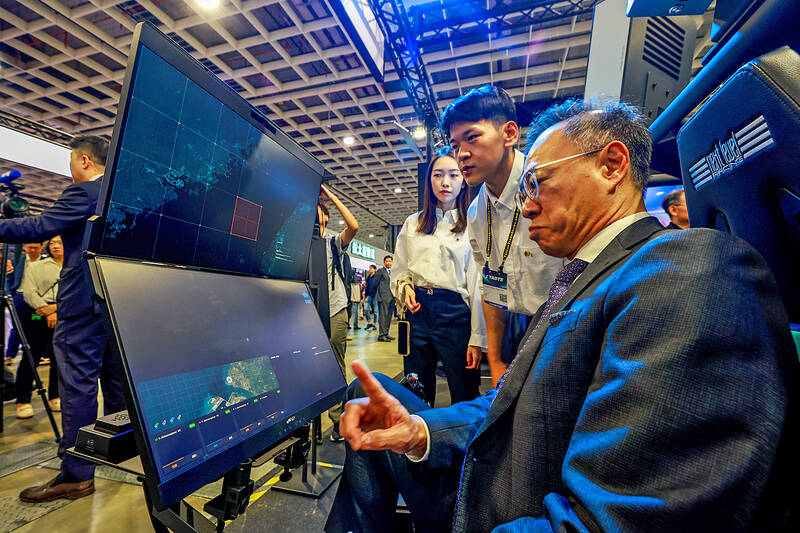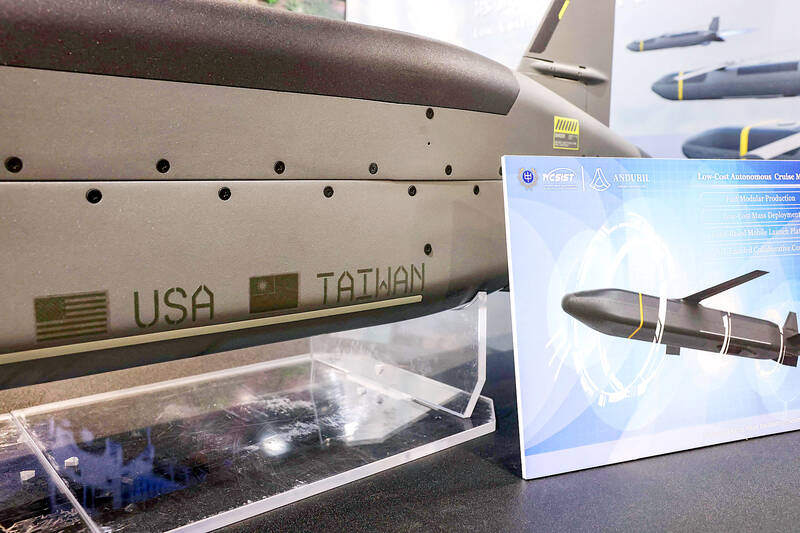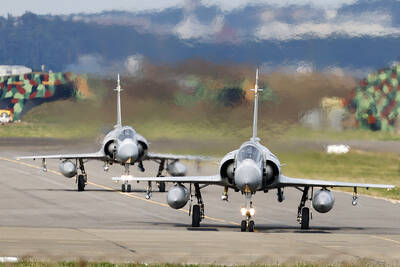The Taipei Aerospace and Defense Exhibition opened yesterday, showcasing 51 new military systems and a record number of exhibitors, while deals were signed to coproduce missiles and drones with overseas firms.
The three-day event, which runs through tomorrow at Taipei Nangang Exhibition Center’s Hall 1, features 490 exhibitors at 1,500 booths, up from 275 exhibitors at about 960 booths in 2023.
American Institute in Taiwan Deputy Director Karin Lang told the opening ceremony that the US pavilion had doubled in size since two years ago, with more than 40 companies this time.

Photo: Ritchie B. Tongo, EPA
“When American and Taiwan companies collaborate, they create solutions that enhance not just bilateral interests, but contribute to broader regional security and prosperity,” Lang told an audience that included Minister of National Defense Wellington Koo (顧立雄).
“Supply chain vulnerabilities, technological competition [and] evolving security threats require us to work even more closely with trusted partners,” she said.
On Wednesday, Taiwan unveiled its first missile jointly made with a US company, marking a major step in the fast-growing defense cooperation of the two nations.

Photo: Ritchie B. Tongo, EPA
The Chungshan Institute of Science and Technology said that it would sign a series of deals with US and Canadian companies for weapons such as anti-drone rockets from Canada’s AirShare and underwater surveillance drones from US firm Anduril.
The institute earlier this year inked a deal with Anduril to jointly make the company’s Barracuda-500, a low-cost, autonomous cruise missile.
Yesterday, the institute and Anduril signed an agreement to coproduce the company’s underwater drone.

Photo: AFP
They are Taiwan’s first such agreements with a foreign company, institute president Lee Shih-chiang (李世強) said.
“Our goal is that if war or a blockade starts, we would be able to manufacture every weapon we need to protect ourselves,” Lee said on the sidelines of the expo, where the Barracuda is on display.
Anduril’s Taiwan head Alex Chang said that the focus of the joint cooperation was on “mass producibility” and making local production sustainable.
The institute said that it would take 18 months to build a supply chain for the Barracuda-500 in Taiwan, with 100 percent Taiwanese components to be used.
The Ministry of National Defense’s pavilion is divided into four sections: joint operations weapons, uncrewed systems, dual-use technologies and talent recruitment.
Displays include hardware, models, multimedia exhibits and interactive simulators, with guided tours to boost public understanding of Taiwan’s defense capabilities.
The joint operations section highlights 20 new systems such as the M1A2T tank, the High Mobility Artillery Rocket System, Chiang Kung (強弓, “Strong Bow”) missiles and Humvee-mounted TOW 2B anti-tank systems, as well as models of the AT-5 Yung Ying (勇鷹, “Brave Eagle”) advanced trainer jet and a light frigate.
Together, the items reflect Taiwan’s multidomain deterrence strategy, the ministry said.
Reflecting on lessons from the war in Ukraine, the ministry said that its uncrewed systems section features 19 systems, including Mighty Hornet attack drones, an electric autonomous tactical vehicle, an uncrewed surface vehicle and an autonomous underwater vehicle.
Models of the Switchblade 300 and ALTIUS 600M drones are also on display, underscoring Taiwan’s drive to improve its asymmetric warfare capabilities and expand its domestic drone industry, the ministry said.
The dual-use technology section includes innovations such as transparent electromagnetic pulse-shielding windows, a DTC VHF radio and a next-generation intelligent security monitoring system.
Developed through a defense-industry-academic collaboration, the projects aim to advance defense self-reliance and boost economic growth, the ministry said.
Previous exhibitions have had total attendance of about 40,000, highlighting public support for national defense, the ministry added.
To further engage the public, this year’s exhibition has a recruitment area, interactive experiences and guided tours, it said.
Taiwan has set a goal of spending 5 percent of GDP on defense by 2030, up from 3.3 percent next year.
The increased defense spending is likely to lead to a minimum procurement of US$50 billion to US$60 billion of military hardware, US-Taiwan Business Council president Rupert Hammond-Chambers said before the show opened.
“About a third ... will go domestic — subsystems of that will go international — and then about two-thirds will go international, most of which will go to the United States, but not all,” he said.

The Ministry of Foreign Affairs (MOFA) yesterday said it is closely monitoring developments in Venezuela, and would continue to cooperate with democratic allies and work together for regional and global security, stability, and prosperity. The remarks came after the US on Saturday launched a series of airstrikes in Venezuela and kidnapped Venezuelan President Nicolas Maduro, who was later flown to New York along with his wife. The pair face US charges related to drug trafficking and alleged cooperation with gangs designated as terrorist organizations. Maduro has denied the allegations. The ministry said that it is closely monitoring the political and economic situation

UNRELENTING: China attempted cyberattacks on Taiwan’s critical infrastructure 2.63 million times per day last year, up from 1.23 million in 2023, the NSB said China’s cyberarmy has long engaged in cyberattacks against Taiwan’s critical infrastructure, employing diverse and evolving tactics, the National Security Bureau (NSB) said yesterday, adding that cyberattacks on critical energy infrastructure last year increased 10-fold compared with the previous year. The NSB yesterday released a report titled Analysis on China’s Cyber Threats to Taiwan’s Critical Infrastructure in 2025, outlining the number of cyberattacks, major tactics and hacker groups. Taiwan’s national intelligence community identified a large number of cybersecurity incidents last year, the bureau said in a statement. China’s cyberarmy last year launched an average of 2.63 million intrusion attempts per day targeting Taiwan’s critical

‘SLICING METHOD’: In the event of a blockade, the China Coast Guard would intercept Taiwanese ships while its navy would seek to deter foreign intervention China’s military drills around Taiwan this week signaled potential strategies to cut the nation off from energy supplies and foreign military assistance, a US think tank report said. The Chinese People’s Liberation Army (PLA) conducted what it called “Justice Mission 2025” exercises from Monday to Tuesday in five maritime zones and airspace around Taiwan, calling them a warning to “Taiwanese independence” forces. In a report released on Wednesday, the Institute for the Study of War said the exercises effectively simulated blocking shipping routes to major port cities, including Kaohsiung, Keelung and Hualien. Taiwan would be highly vulnerable under such a blockade, because it

UNDER WAY: The contract for advanced sensor systems would be fulfilled in Florida, and is expected to be completed by June 2031, the Pentagon said Lockheed Martin has been given a contract involving foreign military sales to Taiwan to meet what Washington calls “an urgent operational need” of Taiwan’s air force, the Pentagon said on Wednesday. The contract has a ceiling value of US$328.5 million, with US$157.3 million in foreign military sales funds obligated at the time of award, the Pentagon said in a statement. “This contract provides for the procurement and delivery of 55 Infrared Search and Track Legion Enhanced Sensor Pods, processors, pod containers and processor containers required to meet the urgent operational need of the Taiwan air force,” it said. The contract’s work would be